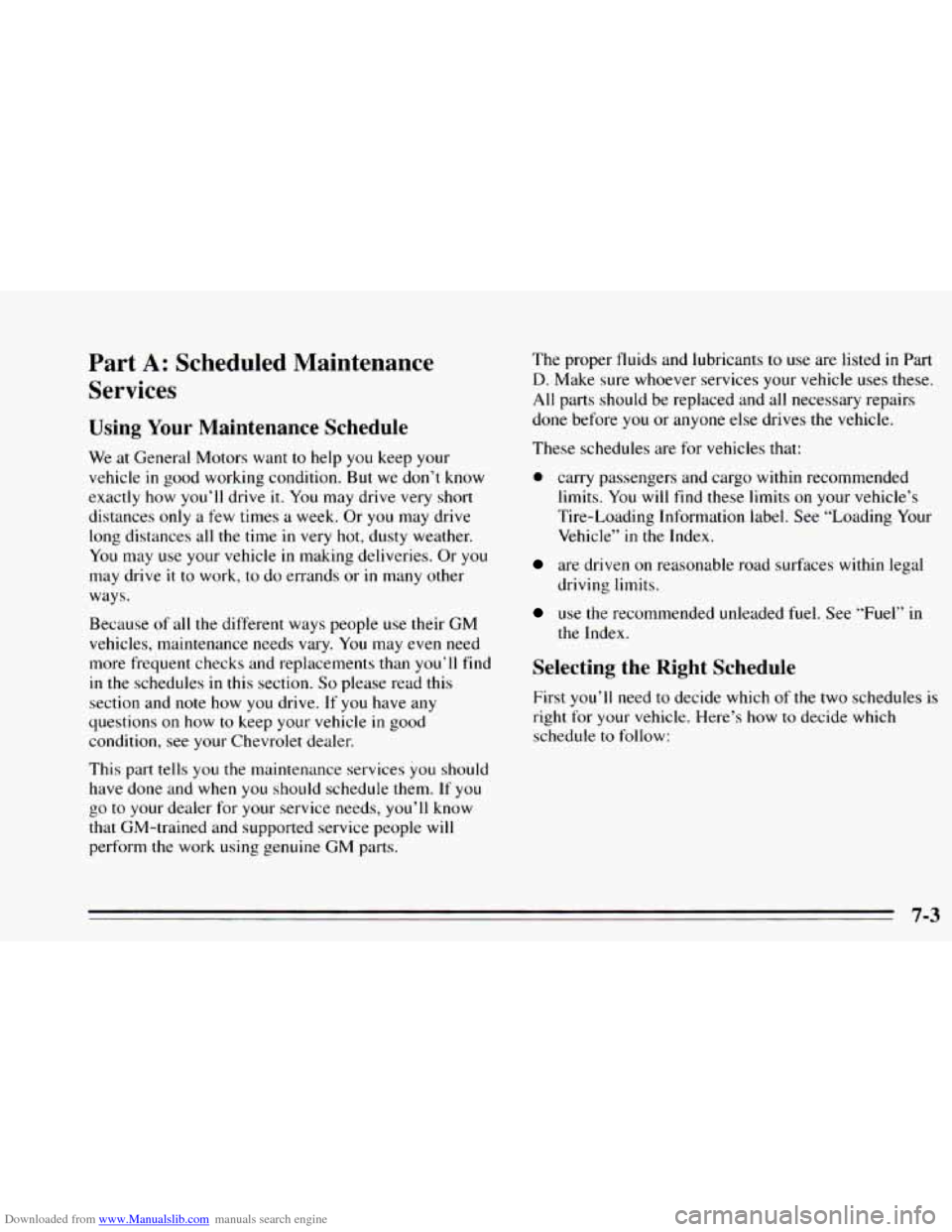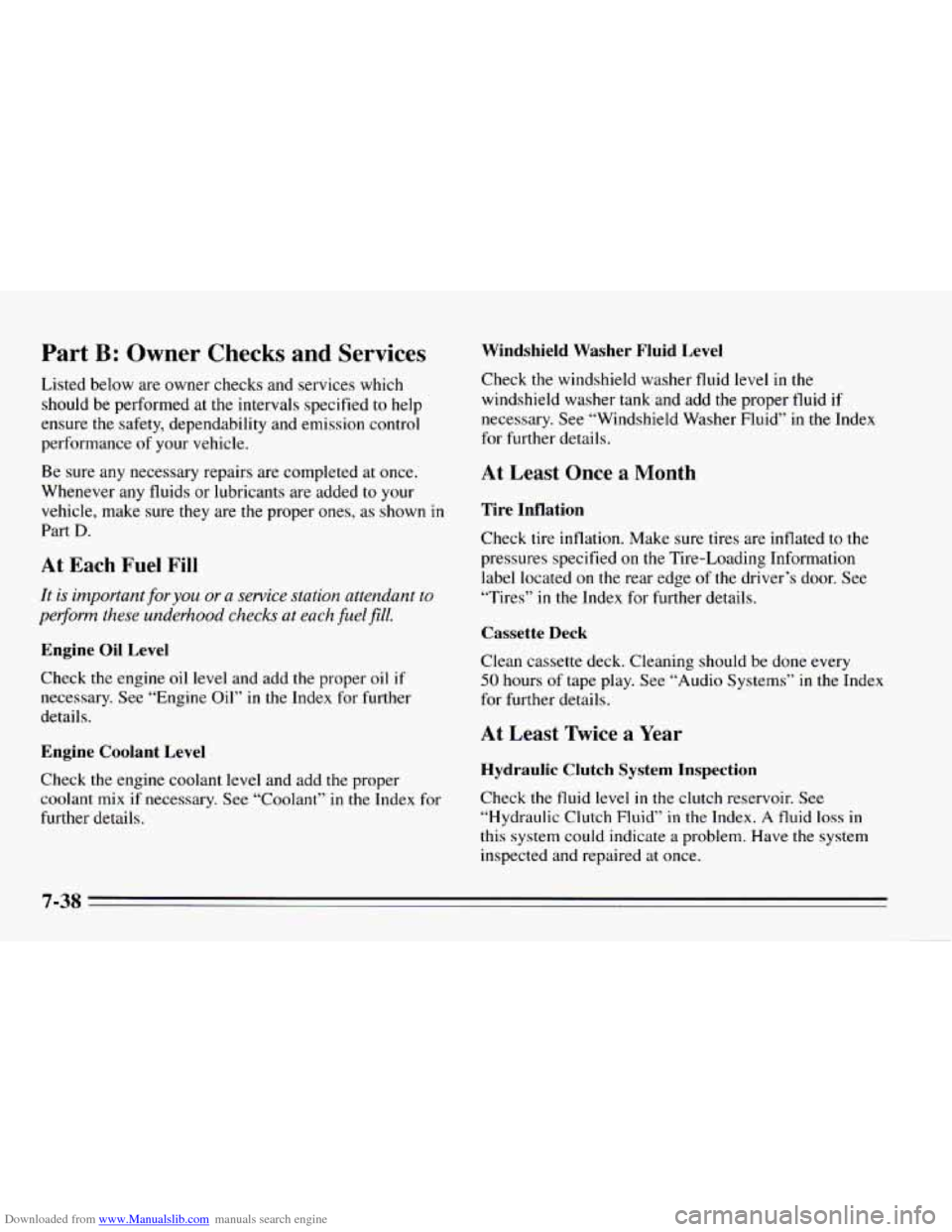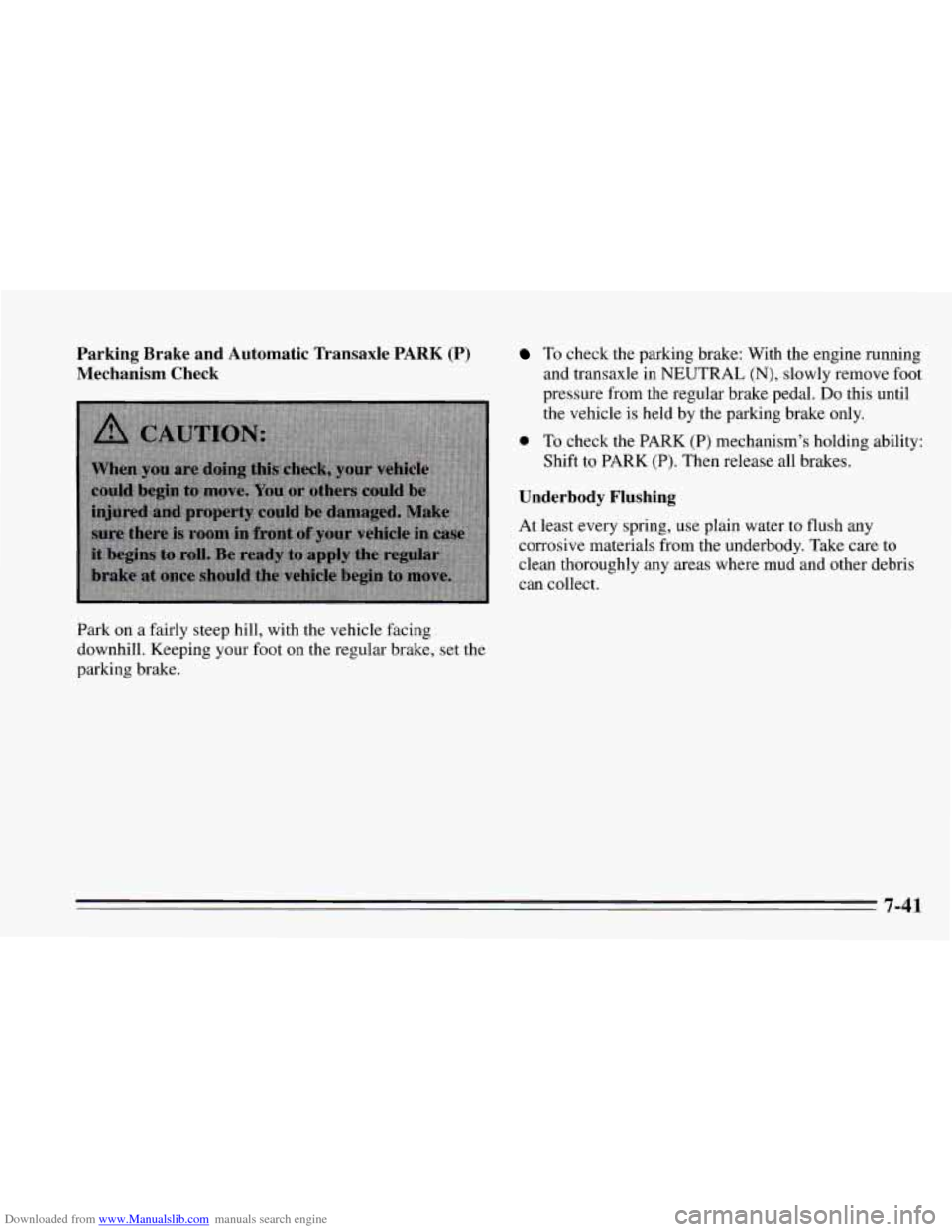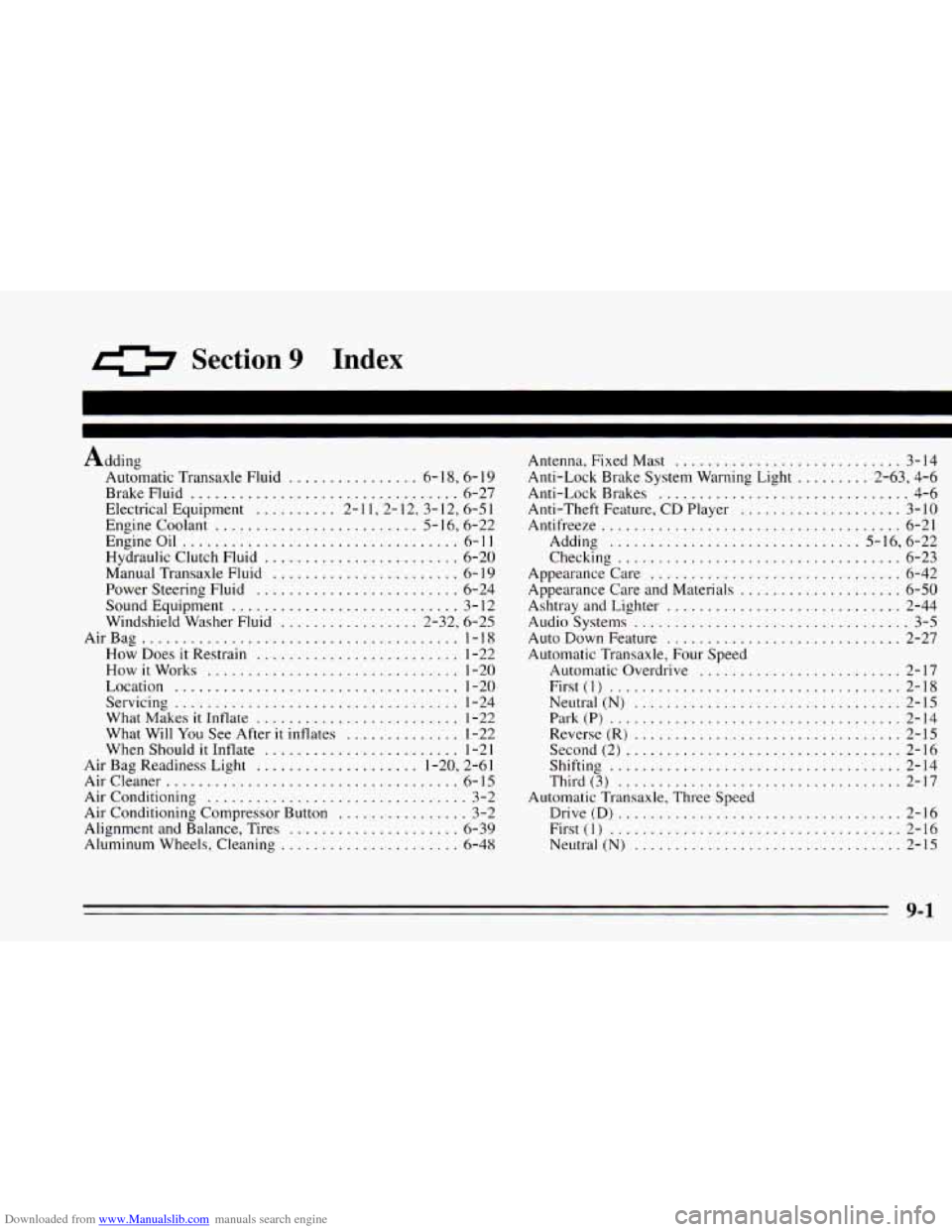1995 CHEVROLET CAVALIER check engine
[x] Cancel search: check enginePage 264 of 340

Downloaded from www.Manualslib.com manuals search engine How This Section is Organized
The remainder of this section is divided into five parts:
“Part A: Scheduled Maintenance Services’’ shows
what
to have done and how often. Some of these
services can be complex,
so unless you are technically
qualified and have the necessary equipment,
you should
let your dealer’s service department or another qualified
service center do these jobs.
If you are skilled enough to do some work
on your
vehicle,
you will probably want to get the service
information
GM publishes. See “Service Publications”
in
the Index.
“Part B: Owner Checks and Services” tells you what
should be checked whenever you stop for fuel. It also
explains what you can easily
do to help keep your
vehicle
in good condition.
“Part C: Periodic Maintenance Inspections’’ explains
important inspections that your Chevrolet dealer’s
service department or another qualified service center
should perform.
“Part D: Recommended Fluids and Lubricants” lists
some products
GM recommends to help keep your
vehicle properly maintained. These products,
or their
equivalents, should be used whether
you do the work
yourself or have
it done.
“Part E: Maintenance Record” provides a place for
you
to record the maintenance performed on your
vehicle. Whenever any maintenance is performed, be
sure to write
it down in this part. This will help you
determine when your next maintenance should be done.
In addition,
it is a good idea to keep your maintenance
receipts. They may be needed
to qualify your vehicle for
warranty repairs.
7-2
Page 265 of 340

Downloaded from www.Manualslib.com manuals search engine Part A: Scheduled Maintenance
Services
Using Your Maintenance Schedule
We at General Motors want to help you keep your
vehicle
in good working condition. But we don’t know
exactly how
you’ll drive it. You may drive very short
distances
only a few times a week. Or you may drive
long distances all
the time in very hot, dusty weather.
You may
use your vehicle in making deliveries. Or you
may drive
it to work, to do errands or in many other
ways.
Because
of all the different ways people use their GM
vehicles, maintenance needs vary.
You may even need
more frequent checks and replacements than you’ll find
in the schedules in this section. So please read this
section and note how
you drive. If you have any
questions
on how to keep your vehicle in good
condition, see your Chevrolet dealer.
This part tells you the maintenance services
you should
have done and when you should schedule them.
If you
go to your dealer for
your service needs, you’ll know
that GM-trained and supported service people
will
perform the work using genuine GM parts.
The proper fluids and lubricants to use are listed in Part
D. Make sure whoever services your vehicle uses these.
All parts should be replaced and all necessary repairs
done before
you or anyone else drives the vehicle.
These schedules are for vehicles that:
0 carry passengers and cargo within recommended
limits. You will find these limits on your vehicle’s
Tire-Loading Information label. See “Loading Your
Vehicle”
in the Index.
are driven on reasonable road surfaces within legal
driving limits.
use the recommended unleaded fuel. See “Fuel” in
the Index.
Selecting the Right Schedule
First you’ll need to decide which of the two schedules is
right for your vehicle. Here’s how to decide which
schedule
to follow:
7-3
Page 300 of 340

Downloaded from www.Manualslib.com manuals search engine Part B: Owner Chews and Services
Listed below are owner checks and services which
should be performed at the intervals specified to help
ensure the safety, dependability and emission control
performance of your vehicle.
Be sure any necessary repairs are completed at once.
Whenever any fluids or lubricants are added
to your
vehicle, make sure
they are the proper ones, as shown in
Part D.
At Each Fuel Fill
It is important for you or a service station attendant to
pe$orm these underhood checks at each fuel fill.
Engine Oil Level Windshield Washer Fluid Level
Check the windshield washer fluid level
in the
windshield washer tank and add the proper fluid
if
necessary. See “Windshield Washer Fluid” in the Index
for further details.
At Least Once a Month
Tire Inflation
Check tire inflation. Make sure tires are inflated to the
pressures specified on the Tire-Loading Information
label located
on the rear edge of the driver’s door. See
“Tires”
in the Index for further details.
Cassette Deck
Clean cassette deck. Cleaning should be done every
50 hours of tape play. See “Audio Systems’’ in the Index
for further details.
Check the engine oil level
and add the proper oil if
necessary. See “Engine Oil” in the Index for further
details.
At Least Twice a Year
Engine Coolant Level
Check the engine coolant level and add the proper
coolant mix if necessary. See “Coolant”
in the Index for
further details.
Hydraulic Clutch System Inspection
Check the fluid level in the clutch reservoir. See
“Hydraulic Clutch Fluid“ in the Index.
A fluid loss in
this system could indicate
a problem. Have the system
inspected and repaired at once.
7-38
Page 303 of 340

Downloaded from www.Manualslib.com manuals search engine Parking Brake and Automatic "ransaxle PARK (P)
Mechanism Check
Park on a fairly steep hill, with the vehicle facing
downhill. Keeping your foot on the regular brake, set the
parking brake.
To check the parking brake: With the engine running
and transaxle in NEUTRAL
(N), slowly remove foot
pressure from the regular brake pedal.
Do this until
the vehicle is held by the parking brake only.
0 To check the PARK (P) mechanism's holding ability:
Shift to
PARK (P). Then release all brakes.
Underbody Flushing
At least every spring, use plain water to flush any
corrosive materials from the underbody. Take care to
clean thoroughly any areas where mud and other debris
can collect.
7-41
Page 304 of 340

Downloaded from www.Manualslib.com manuals search engine Part C: Periodic Maintenance
Inspections
Listed below are inspections and services which should
be performed at least twice a year (for instance, each
spring and fall). You should let your
GM dealer’s
service department or other qualified service center do
these
jobs. Make sure any necessary repairs are
completed at once.
Restraint Systems
Now and then, make sure all your belts, buckles, latch
plates, retractors, anchorages and reminder systems are
working properly. Look for any loose parts or damage.
If you see anything that might keep a restraint system
from doing its job, have it repaired.
Steering, Suspension and Front-Wheel-Drive
Axle Boot and Seal Inspection
Inspect the front and rear suspension and steering
system for damaged, loose or missing parts, signs
of
wear, or lack of lubrication. Inspect the power steering
lines and hoses for proper hookup, binding, leaks,
cracks, chafing, etc. Clean and then inspect the drive
axle boot seals for damage, tears or leakage. Replace
seals if necessary.
Exhaust System Inspection
Inspect the complete exhaust system. Inspect the body near
the exhaust system.
Look for broken, damaged, missing or
out-of-position
parts as well as open seams, holes, loose
connections, or other conditions which could cause a heat
build-up in the floor pan or could let exhaust fumes into
the vehicle. See “Engine Exhaust”
in the Index.
Throttle Linkage Inspection
Inspect the throttle linkage for interference or binding, and f\
or
damaged or missing parts. Replace parts
as needed.
Accelerator and cruise control cables should not
be lubricated.
Manual Transaxle
Check the transaxle fluid level; add if needed. See
“Manual Transaxle” in the Index.
A fluid loss may
indicate a problem. Check the system and repair
if needed.
Brake System Inspection
Inspect the complete system. Inspect brake lines and
hoses for proper hookup, binding, leaks, cracks, chafing,
etc. Inspect disc brake pads for wear and rotors for
surface condition.
Also inspect drum brake linings for
wear and cracks. Inspect other brake parts, including
drums, wheel cylinders, calipers, parking brake, etc.
Check parking brake adjustment.
You may need to have
your brakes inspected more often if your driving habits
or conditions result in frequent braking.
7-42
~
Page 307 of 340

Downloaded from www.Manualslib.com manuals search engine Part E: Maintenance Record
After the scheduled services are performed, record the
date, odometer reading and who performed the service
in the boxes provided after the maintenance interval. Any
additional information from “Owner Checks and
Services” or “Periodic Maintenance” can be added on
the following record pages. Also, you should retain all
maintenance receipts. Your owner information portfolio
is
a convenient place to store them.
7-45
Page 327 of 340

Downloaded from www.Manualslib.com manuals search engine 0 Section 9 Index
Adding Automatic Transaxle Fluid
................ 6- 18. 6- 19
BrakeFluid ................................. 6-27
Electrical Equipment
.......... 2-1 1 , 2- 12, 3- 12, 6-5 1
Engine Coolant ......................... 5- 16, 6-22
Engineoil
.................................. 6-11
Hydraulic Clutch Fluid ........................ 6-20
Manual Transaxle Fluid
....................... 6- 19
Power Steering Fluid ......................... 6-24
SoundEquipment
............................ 3-12
Windshield Washer Fluid
................. 2-32, 6-25
AirBag
....................................... 1-18
How Does
it Restrain ......................... 1-22
Howitworks
............................... 1-20
Location
................................... 1-20
Servicing
................................... 1-24
What Makes
it Inflate ......................... 1-22
What Will You See After it inflates .............. 1-22
When Should
it Inflate ........................ 1-2 1
Air Bag Readiness Light .................... 1-20, 2-61
Aircleaner
.................................... 6-15
Air Conditioning ................................ 3-2
Air Conditioning Compressor Button
................ 3-2
Alignment and Balance, Tires
..................... 6-39
Aluminum Wheels, Cleaning ...................... 6-48
Antenna. Fixed Mast ............................ 3-14
Anti-Lock Brake System Warning Light
......... 2.63. 4.6
Anti-Lock Brakes
............................... 4-6
Anti-Theft Feature.
CD Player .................... 3-10
Antifreeze ..................................... 6-21
Adding
............................... 5.16. 6.22
Checking
................................... 6-23
Appearance Care
............................... 6-42
Appearance Care and Materials
.................... 6-50
Ashtray and Lighter ............................. 2-44
Audiosystems
.................................. 3-5
Auto Down Feature
............................. 2-27
Automatic Transaxle.
Four Speed
Automatic Overdrive
......................... 2-17
First(1)
.................................... 2-18
Neutral
(N) ................................. 2-15
Park(P) .................................... 2-14
Reverse(R)
................................. 2-15
Second(2)
.................................. 2-16
Shifting
.................................... 2-14
Third (3)
................................... 2-17
Drive(D)
................................... 2-16
First(1)
.................................... 2-16
Neutral (N)
................................. 2-15
Automatic Transaxle. Three Speed
9-1
Page 328 of 340

Downloaded from www.Manualslib.com manuals search engine Park(P) .................................... 2-14
Reverse(R)
................................. 2-15
Second(2)
.................................. 2-16
Shifting
.................................... 2-14
Automatic Transaxle Fluid ................... 6- 16. 6- 19
Adding
............................... 6- 18. 6- 19
Checking .............................. 6.16. 6.19
Battery.
LOW Maintenance ....................... 6-29
Battery Rundown Protection
...................... 2-4 1
Battery Warnings ............................ 5.2. 5.4
BBB Auto Line
................................. 8-3
Brake Adjustment
.............................. 6-28
Brake Fluid. Adding
............................. 6-27
Brake Master Cylinder
........................... 6-26
BrakePedalTravel
.............................. 6-28
Brake System Parts. Replacing
.................... 6-28
Brake System Warning Light
...................... 2-62
Brake-Transaxle Shift Interlock
............... 2-24. 7-40
BrakeWear
.................................... 6-27
Brake. Parking
................................. 2-21
Brakes. Anti-Lock
............................... 4-6
Brakes. Trailer
................................. 4-33
Braking
........................................ 4-5
Braking
in Emergencies ........................... 4-8
BTSI (Brake-Transaxle Shift Interlock)
......... 2-24. 7-40
Bulbs, Replacement
............................. 6-56
Headlamps
................................. 6-29
Taillamps
................................... 6-31 Canadian
Roadside Assistance
.................... 8-8
Capacities and Specifications ...................... 6-55
Carbon Monoxide .................... 2.25.4.25. 4.33
Cassette Tape Player Care
........................ 3-13
CDErrors
...................................... 3-9
CD Player Anti-Theft Feature
..................... 3- IO
Center Console Compartment ..................... 2-46
Center Passenger Position
........................ 1-31
Certification/TIre Label
.......................... 4-28
Chains. Safety
................................. 4-33
Chains. Tire
................................... 6-41
Changing a Flat Tire
............................. 5-20
Charging System Light
.......................... 2-66
Check Engine Light
............................. 2-68
Check Gages Light
.............................. 2-64
CheckOilLight
................................ 2-66
Checking Automatic Transaxle Fluid
................ 6- 16. 6- 19
BrakeFluid ................................. 6-26
Enginecoolant
.............................. 6-23
Engineoil
.................................. 6-10
Hydraulic Clutch Fluid
........................ 6-20
Manual Transaxle Fluid
....................... 6-19
Power Steering Fluid
......................... 6-24
Things Under the Hood
........................ 6-6
Checking Your Restraint Systems
.................. 1-45
Chemical Paint Spotting
.......................... 6-49
Child Restraints
................................ 1-34
Securing
in a Rear Outside Seat Position .......... 1-36
Securing
in the Center Rear Seat Position ......... 1-38
Securing
in the Right Front Seat Position .......... 1-40
9-2